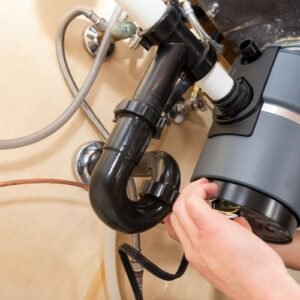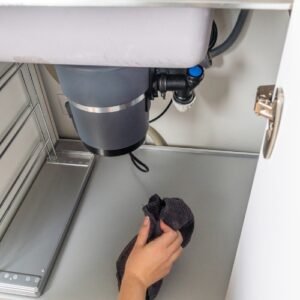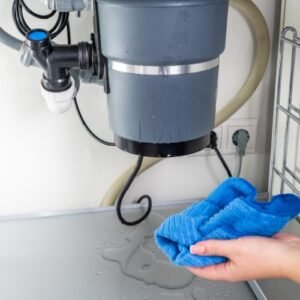Transform Your Broken Garbage Disposal in 3 Simple Steps
Understanding Your Garbage Disposal
Before diving into troubleshooting and repairs, it’s crucial to have a basic understanding of what a garbage disposal is and how it operates. This foundational knowledge will help you diagnose issues more accurately and handle your appliance with confidence.
The Basics of Garbage Disposal Design
A garbage disposal is essentially a compact, electrically powered device installed under the kitchen sink. It’s connected to the drain and designed to shred food scraps into tiny pieces (no larger than 2 mm) so they can pass through plumbing without causing clogs. The primary components of garbage disposal include:
- Motor: Typically ranging from 1/3 to 1 horsepower, the motor provides the power needed to spin the grinding plates or impellers at high speeds.
- Grinding Chamber: This is where food waste is pulverized. Inside, impellers mounted on a spinning plate force food against a stationary grind ring, breaking it down into small particles.
- Hopper Chamber: Food waste is fed into this upper section of the disposal before being pushed down into the grinding chamber.
- Flywheel: Attached to the motor, the flywheel includes impellers that help push food into the grind ring.
- Reset Button: If the disposal overheats or jams, this button can be used to reset the motor.
- Drain Pipe: After food is ground, it is flushed through the drain pipe into the home’s plumbing system.
How Does It Work?
When you turn on the garbage disposal, the motor powers up, and the flywheel begins to spin. The impellers attached to the flywheel thrust the food scraps against the stationary grind ring. The force and motion create sufficient friction to grind the food into fine particles, which are then flushed down the drain by a stream of water from the sink faucet.
Safety Features
Safety is a significant concern with garbage disposals, as their sharp components and electric operation can pose risks. Most units are equipped with an overload protector that triggers an automatic shutoff if the motor overheats or if a jam occurs. This is where the reset button comes into play, allowing the unit to be easily restarted once the issue is resolved.
Understanding these basic components and their functions not only demystifies how the appliance works but also informs safer and more effective handling during maintenance and troubleshooting. With this knowledge as your foundation, you’re better prepared to delve into the common issues that can arise with garbage disposals and how to address them effectively.
Common Problems, Symptoms, Diagnoses, and Solutions for a Broken Garbage Disposal
A broken garbage disposal can manifest several symptoms, each pointing to different underlying issues. Here, we explore the most common problems that can lead to broken garbage disposal, along with their symptoms, diagnoses, and step-by-step solutions to get your appliance back in working order.
1. Jammed Disposal
Symptoms: The motor hums without the grinding action, or the disposal makes no sound at all when turned on.
Diagnosis: A jam occurs when hard objects, fibrous materials, or too much waste at once gets caught in the grinding chamber, preventing the impellers from moving.
Solution:
- First, ensure the power to the disposal is turned off for safety.
- Insert an Allen wrench into the hole at the bottom of the disposal unit and turn back and forth to free the impellers.
- Use tongs or pliers (never your hands) to remove the obstructing items from the top.
2. Clogged Drain
Symptoms: Water doesn’t drain or drains very slowly through the sink where the disposal is installed.
Diagnosis: A clog can occur either in the drainpipe leading from the disposal or further down the plumbing. This may not always indicate a broken garbage disposal but can affect its efficiency.
Solution:
- Disconnect power to the disposal.
- Check the drain trap for clogs and clear any debris.
- Use a plunger or a plumber’s snake to clear obstructions in the drainpipe.
3. Overheating
Symptoms: Disposal stops working or shuts off during use.
Diagnosis: Overheating can be caused by a jam, excessive use without breaks, or an aging motor, indicating a potentially broken garbage disposal.
Solution:
- Press the reset button on the bottom of the disposal after it cools down.
- Remove any jams as described above.
- Limit the amount of time the disposal runs continuously to prevent future overheating.
4. Leaking Disposal
Symptoms: Water pooling under the sink.
Diagnosis: Leaks can come from the sink flange, the hose connections, or the body of the disposal itself, which might suggest a crack or deterioration in a broken garbage disposal.
Solution:
- Identify the source of the leak. Tighten any loose connections.
- Replace the sink flange gasket or the disposal unit if the body is cracked.
5. Electrical Issues
Symptoms: No power to the disposal, the reset button trips frequently.
Diagnosis: Wiring issues, faulty connections, or a tripped breaker can cause electrical failures in a broken garbage disposal.
Solution:
- Check and reset the circuit breaker.
- Ensure the disposal unit is plugged in.
- Replace any faulty or old wiring if comfortable with electrical work, or consult a professional.
6. Noise Issues
Symptoms: Unusual noises like clattering, grinding, or screeching.
Diagnosis: Objects trapped in the disposal, misalignment of parts, or mechanical failure can be the culprits behind noisy operations in a broken garbage disposal.
Solution:
- Turn off the power and visually inspect for any foreign objects. Remove them carefully.
- If the noise persists after clearing the disposal, this might indicate a need for professional repair or replacement of the unit.
By recognizing these common symptoms and applying the correct diagnoses and solutions, you can effectively address issues with a broken garbage disposal. Regular maintenance and cautious use can prevent many of these problems, ensuring that your garbage disposal remains a reliable tool in your kitchen.
Choosing the Right Replacement for a Broken Garbage Disposal
When your broken garbage disposal is beyond repair, choosing the right replacement becomes your next step. A broken garbage disposal can cause significant inconvenience, so finding a suitable new unit is crucial. Here’s a detailed guide on selecting the best replacement for a broken garbage disposal, ensuring smooth operation and long-term reliability.
1. Assess Your Needs
Before purchasing a new garbage disposal to replace your broken unit, consider the specific needs of your household:
- Amount of Waste: How much food waste does your household generate? Larger families might need a more powerful disposal.
- Type of Waste: If you frequently dispose of tough food scraps, such as vegetable peels or small bones, look for a disposal with higher horsepower.
2. Motor Size
The motor size of your new garbage disposal is a critical factor, especially if your previous model was a broken garbage disposal due to insufficient power. Garbage disposals typically range from 1/3 horsepower to 1 horsepower:
- 1/3 to 1/2 Horsepower: Suitable for smaller households or light use. However, they are less durable and more prone to getting jammed.
- 3/4 Horsepower: A good middle ground, offering enough power for most households without frequent jams.
- 1 Horsepower: Best for large households or for those who use their disposal heavily. These units can handle a larger variety of food scraps and operate more quietly.
3. Grinding Chamber Material
The durability of your garbage disposal largely depends on the construction of the grinding chamber. To avoid another broken garbage disposal, opt for a model with stainless steel components:
- Stainless Steel: Offers the best resistance to wear and corrosion, thus prolonging the lifespan of the disposal.
4. Noise Levels
If your broken garbage disposal was particularly noisy, consider looking for a unit that comes with sound insulation. Models with features such as insulated mounting baffles or quieter motors can significantly reduce the noise during operation.
5. Additional Features
Modern garbage disposals come with various features that can provide added convenience and efficiency:
- Anti-Jamming Technology: Some models are equipped with advanced technology to prevent jams, which is a common reason for a garbage disposal to break.
- Batch vs. Continuous Feed: Continuous feed models operate while food waste is added, which is convenient but can be less safe. Batch feed models require the lid to be in place before they operate, enhancing safety.
6. Environmental Considerations
If you’re environmentally conscious, consider the impact of your garbage disposal. Some newer models are designed to be more energy-efficient and may also use less water.
7. Warranty and Support
When replacing a broken garbage disposal, check the warranty and customer support offered by the manufacturer. A longer warranty might indicate a more reliable unit and good customer support can be invaluable if issues arise.
Choosing the right replacement for your broken garbage disposal involves considering several factors, including motor size, grinding chamber material, noise level, and additional features. By carefully selecting a unit that fits the needs of your household and opting for durable materials and innovative technologies, you can avoid the inconvenience of frequent repairs and ensure your kitchen remains functional and efficient. Remember to install your new disposal correctly or hire a professional to ensure it operates at its best. This investment not only improves your daily kitchen experience but also contributes to the overall functionality and value of your home.
Preventative Maintenance to Avoid a Broken Garbage Disposal
Preventative maintenance is key to extending the lifespan of your garbage disposal and preventing it from becoming a broken garbage disposal. By following a few simple guidelines, you can keep your unit running smoothly and efficiently, reducing the likelihood of facing a broken garbage disposal.
Regular Cleaning
Tip: Keep your disposal clean to prevent buildup that can lead to a broken garbage disposal.
How to Do It:
- After use, run cold water through the disposal for about 15 seconds to flush out any remaining particles.
- Once a week, fill the disposal with ice cubes and a cup of rock salt, then run it. This helps clean the grinding elements and ensure they don’t contribute to a broken garbage disposal.
- Use vinegar and baking soda monthly to foam away residue and combat odors that might suggest a slowly failing, or broken garbage disposal.
Proper Usage
Tip: Using your disposal correctly is crucial in preventing a broken garbage disposal.
How to Do It:
- Avoid disposing of hard, fibrous, or starchy wastes like bones, celery, and potato peels, which are common culprits behind a broken garbage disposal.
- Run cold water before, during, and after disposal use to help food particles flow smoothly through the drain, preventing the type of clogs that lead to a broken garbage disposal.
- Cut larger items into smaller pieces before feeding them into the disposal to minimize strain and avoid the potential for a broken garbage disposal.
Routine Inspections
Tip: Regular checks can catch minor issues before they turn into a major broken garbage disposal problem.
How to Do It:
- Periodically inspect for leaks under the sink where the garbage disposal is installed. Catching these early can prevent water damage and a broken garbage disposal.
- Listen for unusual noises or poor performance that might indicate a potential issue, signaling the onset of a broken garbage disposal.
- Ensure that all fittings and connections are tight and secure to avoid vibrations that might loosen components over time, leading to a broken garbage disposal.
Avoiding Chemicals
Tip: Harsh chemicals can damage your disposal, leading to a broken garbage disposal.
How to Do It:
- Steer clear of chemical drain cleaners, which can corrode the metal components of your disposal, accelerating wear and tear toward a broken garbage disposal.
- Opt for natural alternatives like vinegar or a mixture of baking soda and lemon juice for safe cleaning that won’t contribute to a broken garbage disposal.
Professional Maintenance
Tip: Annual professional inspections can prevent unexpected broken garbage disposal issues.
How to Do It:
- Have a professional check your garbage disposal annually. They can handle complex maintenance tasks and spot early signs of what might become a broken garbage disposal.
- Professionals can also make adjustments and repairs that are not safe or suitable for DIY, which can prevent you from facing a completely broken garbage disposal.
By integrating these preventative maintenance steps into your routine, you can significantly lower the chances of dealing with a broken garbage disposal. Regular care not only saves you the hassle and expense of repairs but also keeps your kitchen running smoothly.
Master Your Kitchen: Plumbing Therapist’s Guide to Fixing Your Garbage Disposal
As your go-to experts at Plumbing Therapist, we understand just how disruptive malfunctioning garbage disposal can be in your daily life. Through this comprehensive guide, I’ve shared with you, our valued readers, the essential techniques to diagnose, repair, and maintain your garbage disposal. Our goal is to empower you with the knowledge to handle minor disruptions on your own, ensuring your kitchen operations are as smooth as possible.
However, it’s important to recognize when a problem is beyond a simple fix. In such cases, or whenever you feel out of your depth, We are just a call away. We pride ourselves on our commitment to providing exceptional service and expert advice. Our team of professionals is well-equipped to handle any garbage disposal issue, big or small, with the right tools and expertise to ensure the job is done correctly.
Additionally, regular maintenance by a professional can significantly extend the life of your garbage disposal, preventing potential breakdowns before they occur. Schedule a routine check with us, and let us take care of everything. We can spot early signs of wear and tear and make necessary adjustments to avoid costly repairs down the line.
Remember, at Plumbing Therapist, we’re more than just a service provider; we’re your partner in home maintenance. Trust us to keep your appliances running efficiently so you can focus on what truly matters—enjoying your home and family. Your peace of mind is our top priority, and we’re here to ensure that your kitchen remains a trouble-free zone.





